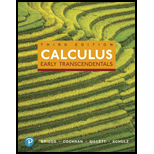
Concept explainers
Identifying surfaces Consider the surfaces defined by the following equations.
a. Identify and briefly describe the surface.
b. Find the xy-, xz-, and yz-traces, when they exist.
c. Find the intercepts with the three coordinate axes, when they exist.
d. Make a sketch of the surface.
12.
Want to see the full answer?
Check out a sample textbook solution
Chapter 13 Solutions
MyLab Math with Pearson eText -- Standalone Access Card -- for Calculus: Early Transcendentals (3rd Edition)
Additional Math Textbook Solutions
Basic Business Statistics, Student Value Edition
Elementary Statistics: Picturing the World (7th Edition)
Calculus: Early Transcendentals (2nd Edition)
A Problem Solving Approach To Mathematics For Elementary School Teachers (13th Edition)
University Calculus: Early Transcendentals (4th Edition)
- 1. Consider the function f(x) whose graph is given below. Use the graph to determine the following: 2 a) All x for which f'(x) is positive. b) All x for which f'(x) is negative. 2 -2 c) The x for which f'(x) is zero. (please depict this on the graph)arrow_forward4. Suppose that the population of a certain collection of rare Brazilian ants is given by P(t)=(t+100) In(t+2), Where t represents the time in days. Find and interpret the rates of change of the population on the third day and on the tenth day.arrow_forwardFind all values of x for f (x)=(x²-4) 4 where the tangent line is horizontal. 5. Find the slope of the tangent line to the graph of f(x)=-√8x+1 at x=1. Write the equation of the tangent line.arrow_forward
- 3. Find the derivative of each function. Label with appropriate derivative notation showing both dependent and independent variables. f(t)=4t(2t⭑+4)³ a. f(t)=4t (2t+4)³ (Answer must be factored.) b. y= 3 1 (2x³-4) 6arrow_forward4.3 The Chain Rule 1. {Algebra review} Let f(x)=2x²-5 x and g(x)=6x+2. Find f[g(−5)]. 2. {Algebra review} Write h(x)=√√8x-3 as the composite of two functions f(x) and g(x). (There may be more than one way to do this.)arrow_forward4.4 Derivatives of Exponential Functions 1. Find derivatives of the functions defined as follows. a. g(t)=-3.4e b. y=e√x c. f(x)=(4x³+2)e³* d. y=- x²arrow_forward
- 4.5 Derivatives of Logarithmic Functions 1. Find the derivative of each function. a) y=ln (-3x) b) f(u)=nu c) 9(x)=x-1 lnxarrow_forward3. If the total revenue received from the sale of x items is given by R(x)=30ln (2x+1), While the total cost to produce x items is C(x)=✗, find the following. a) The marginal revenue b) The profit function P(x) (Hint: P(x)=R(x)-C(x)} c) The marginal profit when x=20 d) Interpret the results of part c).arrow_forward2. The sales of a new personal computer (in thousands) are given by S(t)=100-90€-04: Where t represents time in years. Find and interpret the rate of change of sales at each time. a) After 1 year b) After 5 years c) What is happening to the rate of change of sales as time goes on? d) Does the rate of change of sales ever equal zero?arrow_forward
- 2. Find the equation of the line tangent to the graph of f(x)=ln(x²+5) at the point (-1, In 6). Do not approximate numbers.arrow_forward6. The number of viewers of a television series introduced several years ago is approximated by N(t)=(60+2t2/3,1arrow_forwardsolve please, thank youarrow_forwardarrow_back_iosSEE MORE QUESTIONSarrow_forward_ios
- Algebra & Trigonometry with Analytic GeometryAlgebraISBN:9781133382119Author:SwokowskiPublisher:Cengage
